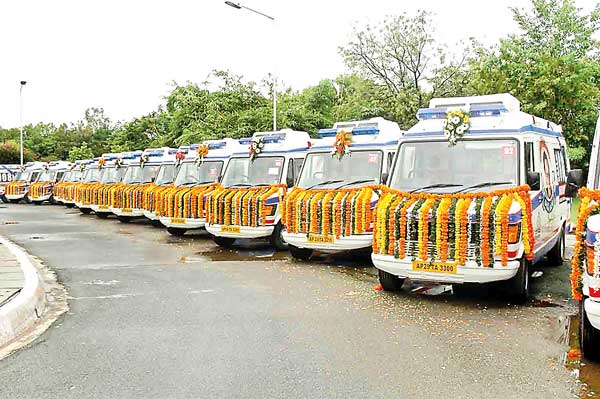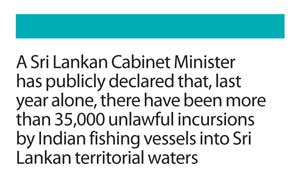Reply To:
Name - Reply Comment
Last Updated : 2024-04-23 22:35:00

In the current debate about the proposed Economic and Technological Co-operation Agreement with India, and its impact on Sri Lanka’s vital economic interests, there are some central issues which must be seen in sharp relief.

It is surely obvious that empirical experience of the working of agreements already in force, provides the most reliable indication of what can realistically be expected, if the scope of such agreements is to be significantly widened. Apart from this, the issue of respect for the rights and interests of the other party is an overriding factor.
The all too grim reality today is that we have been reduced to a state of total impotence in protecting  the marine wealth of our nation. The Sri Lankan media is engaged in highlighting what it rightly describes as “the rape of our seas”. This is no exaggeration, in light of undeniable evidence that, on a daily basis, hundreds of Indian fishing vessels, including trawlers with sophisticated equipment, invade our territorial waters with impunity and take away our country’s valuable fisheries resources, depriving whole communities of their means of livelihood.
the marine wealth of our nation. The Sri Lankan media is engaged in highlighting what it rightly describes as “the rape of our seas”. This is no exaggeration, in light of undeniable evidence that, on a daily basis, hundreds of Indian fishing vessels, including trawlers with sophisticated equipment, invade our territorial waters with impunity and take away our country’s valuable fisheries resources, depriving whole communities of their means of livelihood.
A Sri Lankan Cabinet Minister has publicly declared that, last year alone, there have been more than 35,000 unlawful incursions by Indian fishing vessels into Sri Lankan territorial waters. The monthly loss to us is said to be in excess of Rs. 5,500 million. Every effort to resolve, or even mitigate, this issue has hitherto proved futile. Far from there being any serious attempt to stop or even reduce this continuing trespass and misappropriation, the situation is becoming infinitely worse.
In addition to the pillage of our economic resources, there is the even graver aspect of permanent environmental damage. Numerous complaints have been made over the years that the technique of “bottom trawling” resorted to by Indian fishermen, is inflicting irremediable damage on our sea bed and ocean floor, and the future fisheries resources of Sri Lanka. The response has been to intensify the devastation caused by this practice: there is now bottom trawling not just by single vessels but by clusters of vessels.
In the face of this brazen assault on our national wealth, the government’s response is pathetically timid. A Sri Lankan Cabinet Minister, based in the Vanni area, has assessed the quantum of fish stolen from the waters in his region, as approximately 30,000 metric tonnes. He has recently declared his intention to convene a meeting of the District Development Committee of his area, to have a resolution passed, condemning this practice and imploring that it be stopped.
The Minister of Fisheries has vividly recounted his experience of setting out to sea from Kankesanthurai and observing for himself the plethora of Indian vessels freely fishing in our waters with scant respect for our country and its sovereignty. All he is able to do, for no fault of his, is to plead with Indian Ministers to give themselves the opportunity of seeing with their own eyes the extent of this plunder. Such is the degree of humiliation which has to be endured.
The appalling diffidence of the Sri Lankan authorities is seen in their reluctance to focus on this issue on the most appropriate occasion for the purpose -- the Joint Commission between Sri Lanka and India, which was held recently in Colombo. At the last Joint Commission held during the period of the previous government, we insisted on an explicit reference to this problem and the urgency of a durable solution being arrived at. In sharp contrast, the present government finds itself inhibited even from raising and pursuing so crucial a matter in a meaningful way.
These circumstances naturally give rise to acute anxiety. There can be no conceivable doubt that the action of the Indian fishermen, continuing and expanding with every passing month, is without any vestige of justification. Our territorial waters are in no way different from the land mass of the Island. Sri Lanka has the undisputed right, in international law, to the exclusive use and appropriation of the resources of both.
What is intensely worrying here is our total inability to assert and defend our rights, having as they do a critical bearing on the incomes and livelihoods of a particularly vulnerable section of the Sri Lankan people. Whenever Indian boats and fishermen are taken into custody, there is the strongest possible pressure exerted to secure their release; and this invariably happens in a short time. It is no surprise, then, that they come again and again. The incentive is the richness of our resources, and the only price they pay, if they are arrested -- and this happens only to a very small minority of the invaders -- would be a few days in remand custody, followed by prompt release and a virtual invitation to continue their enterprise indefinitely.
It must not be forgotten that the enterprise has other dimensions as well. Its lucrative character is enhanced by the opportunity to smuggle in drugs and narcotics, which have found their way into the country on many occasions in this way. There is, also, the evident threat to national security, posed by this activity continuing unabated.
We are assured repeatedly that the bilateral agreement contemplated in respect of the services sector will contain explicit provisions which will amply protect the interests of professionals and the business community in our country. This presupposes, however, the sanctity of legal provisions and the enforceability of contractual stipulations.
The assumption is that these will be acknowledged and applied in practice, and that agreements will be honoured in the observance rather than the breach. What will prevail is not brawn or muscle, but mutual rights and obligations which receive expression in an agreement, solemnly concluded between Nation States.
The stark issue, however, is whether this expectation is not embarrassingly naïve in the context of everyday experience. The question, at bottom is, one of political will. If we lack the capability to stand up for our rights in the interest of our people against hugely harmful activity altogether bereft of legal right in any form whatsoever, is it not unpardonably reckless on our part to contemplate the deliberate conferment of far-reaching rights, through the instrument of a treaty between States (with crucial repercussions including WTO involvement) and then try to implement on the ground formal limitations on the range and depth of those rights? The elemental instinct of self-preservation would seem to dictate that palpable injustice in the current context should be effectively addressed and remedied before we venture to accept far great exposure in the future.
Hostility to India or any form of negative feeling with regard to economic relations between the two countries does not, by any means, underpin the strong reservations evident across a wide spectrum of Sri Lankan society in relation to the proposed treaty. Given obvious considerations of scale, capacity and influence, there is no doubt that an equitably structured bilateral relationship is desirable for Sri Lanka. But an essential consideration, surely, is that the overall impact of that relationship should be beneficial, on balance, to our country. Taking fully into account the manifest asymmetry between the size, population and economy of the two countries, the ingredients of the relationship must be conducive to the protection of Sri Lanka’s vital interests, on the basis of a just and fair approach.
The treaty envisaged (ECTA) is one which will have the effect of opening up Sri Lanka’s services sector to India. This is an extension from commodities to services. The export of commodities is already governed by an existing treaty -- the Free Trade Agreement (FTA) between the two countries.
A clearly applicable test, then, is to examine the extent to which the FTA, which has been in operation for a decade and a half, has brought benefits in its wake to Sri Lanka. This is an area where the facts speak irrefutably for themselves.
In 2005, just five years after the FTA came into force, the value of Indian exports into Sri Lanka was USD 1,835 mn while Sri Lanka exported into India goods worth USD 566 mn. The value of total trade between the two countries was USD 2,401 mn of which Sri Lanka enjoyed 24 per cent, while India’s share was 76 per cent.
Ten years later, during the fifteenth year of operation of the FTA, Sri Lanka exported goods worth USD 645 mn to India, while the value of Indian exports to Sri Lanka was USD 4,285 mn. This means that, out of a total trade of USD 4,930 mn, India enjoyed 87 per cent (an increase of 11 per cent over ten years), while Sri Lanka’s share was only 13 per cent (a corresponding decrease of 11 per cent).
At the time when the FTA was under discussion (as the proposed ECTA is now), the projected benefits to Sri Lanka were articulated by its protagonists in the most fulsome terms. Sadly, the sequel shows that, far from this ample promise being in any manner fulfilled, Sri Lanka’s share of bilateral trade, during a decade of operation of the FTA, has actually declined by a proportion as significant as almost one-half.
This outcome, which is likely to surprise most members of the Sri Lankan public, is attributable to both substantive and procedural factors.
From the former perspective, concern for the well-being of Sri Lanka naturally requires that the FTA would entail a premium on facilitation of access into the vast market of the sub-continent for commodities, in the production of which our country has traditional expertise.
The two principal commodities in this category are apparel products and tea, which together account for USD 6 billion out of USD 9 billion which Sri Lanka earns annually from all its exports. And yet, when Sri Lanka exported USD 4,929 mn worth of apparel products two years ago to destinations worldwide, the exports to India amounted to only USD 34 mn or a mere 0.7 per cent of the total. This is because the quantity specification by India was as low as 15 mn pieces for Sri Lanka’s apparel exports.
Similarly, when Sri Lanka exported USD 1,628 mn worth of tea globally in 2014, tea exports to India amounted to USD 17 mn representing a meagre 1 per cent of total exports. Paradoxically, Sri Lanka’s trade performance with countries without an FTA, was incomparably superior.
While Sri Lanka’s strongest exports have received negligible support from the FTA, the situation on the Indian side is strikingly different.
The visual evidence is unmistakable that Sri Lanka is awash with Indian three-wheelers, taxis and small cars. Despite the disproportionate size of our economy, Sri Lanka is the second largest market, globally, for Indian automobiles, one of the inherent strengths of the sub-continent. This market is worth approximately US$ 700 million annually — a figure which exceeds the value of all Sri Lankan exports, taken together, into India.
Sri Lanka, likewise, is a very substantial market for India in several other sectors including textiles, cement and steel.
Apart from the substantive aspects pertaining to commodity specifications, the cumulative effect of procedural fetters, imposed in India by administrative means, has proved decisive. The fetters consist, inter alia, of a dilatory and cumbersome import licensing procedure, restrictions in respect of entry ports and timing for the reception of imports, customs, certification and quarantine regulations, as well as divergent taxes and levies imposed by different Indian States. These impediments, to the constant chagrin of Sri Lankan exporters, had the necessary effect of stultifying, to a large extent in practice, the entitlements guaranteed by the FTA.
These are the reasons for widespread scepticism regarding present-day eulogies about professed advantages of ECTA. This disillusionment can be dispelled only by concrete action to remove the hindrances, before further expansion is embarked upon.
It is against this backdrop, which raises in a crisp form the perceived relegation of the core interests of the smaller, to those of the larger, country, that the present controversy regarding the Indian ambulance service requires appraisal.
Among all nations of South Asia, it is beyond dispute that the standards achieved by Sri Lanka in the health sector are pre-eminent.
Our pervasive network of rural hospitals, base hospitals and teaching hospitals, supported by family health units, midwives and para-medical personnel penetrating deep into the Island’s interior, has made possible a degree of access to health-care which is, quite legitimately, the envy of the region. Our medical services are manned by 1,100 specialists in all the major areas of specialization in medicine and surgery, assisted by 300 recently retired consultants. 95 per cent of deliveries in the country now take place in hospitals, instead of at home. Our mortality and morbidity statistics, and our life expectancy for men as well as women (10 years longer than in India) are on par with countries in East Asia rather than South Asia. A free health service, which pre-dates Independence, is deeply rooted in the culture and social traditions of our people.
The proposal now being debated vigorously involves 88 ambulances, to be brought into the country from India, while provision is made for 600 supporting personnel. Integral to the proposal is an unspecified number of health centres which the specially chosen Indian NGO is empowered to establish, at its own discretion and without limit. The operations of the NGO are assured a high degree of autonomy, supplemented by the advantage of collaboration with Sri Lankan security and
administrative personnel.
It has now been declared that Sri Lanka is required to make monetary compensation for the recurrent expenditure incurred by the Indian NGO. In addition, land and other facilities for establishment of health centres by this NGO will have to be provided by the
Government of Sri Lanka.
This entire arrangement is restricted to a one-year time frame. The future of the initiative thereafter is tantalizingly obscure. If it is intended that Sri Lankan companies are to be afforded the opportunity to compete for entry after the lapse of this period, there is manifest absence of a level playing field. The Indian NGO, utilizing at least in part Sri Lankan resources, has the fullest advantage of entrenchment in the health system, having consolidated its commercial goodwill and its brand reputation in consequence of its monopoly of operations over the initial period.
This is, surely, an inversion of proprieties dictated by the national interest. The far preferable course of action would have been to deploy Sri Lankan resources for strengthening the capacity of well established Sri Lankan hospital conglomerates such as Nawaloka, Hemas, Asiri, Lanka Hospitals and Durdans, to augment and improve their already existing ambulance services and to review the situation at the end of the initial period.
The Indian contribution could then have consisted, much more acceptably, of the import component of the project -- namely, the cost of the ambulances.
Each ambulance will need to be manned by at least 5 persons to provide an emergency service. The project involves chauffeurs, mechanics, maintenance officials and para-medical personnel.
Other staff, including qualified doctors, will be required for the health centres. On the terms advertised by the NGO in the Sri Lankan Press (Rs. 25,000 per month for a chauffeur having competence in English and working a 12-hour shift), Sri Lankans are exceedingly unlikely to be available in sufficient numbers for employment. The remuneration offered is well below the threshold of salaries payable to skilled grades of labour in Sri Lanka. Probably for this reason, specific provision is made for issuing visas for
implementation of the project.
The Indian NGO has, at its disposal, access to a wide gamut of information relating to topography, population, community practices and other matters. This could clearly have security implications. It is also suggestive of an incipient measure of privatisation of the health service. There would necessarily be critical decision making by the NGO with regard to the hospital to which the patient is referred, after emergency care on board the ambulance and at the
NGO’s health centres.
There remains another intriguing feature which warrants reflection. If the purpose of the proposal is the alleviation of hardship, it is far from obvious why the Western and Southern Provinces should have been selected for the initial phase of the project, to the exclusion of, for instance, the Districts of Moneragala or Polonnaruwa where the need is demonstrably greater.

Add comment
Comments will be edited (grammar, spelling and slang) and authorized at the discretion of Daily Mirror online. The website also has the right not to publish selected comments.
Reply To:
Name - Reply Comment
On March 26, a couple arriving from Thailand was arrested with 88 live animal
According to villagers from Naula-Moragolla out of 105 families 80 can afford
Is the situation in Sri Lanka so grim that locals harbour hope that they coul
A recent post on social media revealed that three purple-faced langurs near t